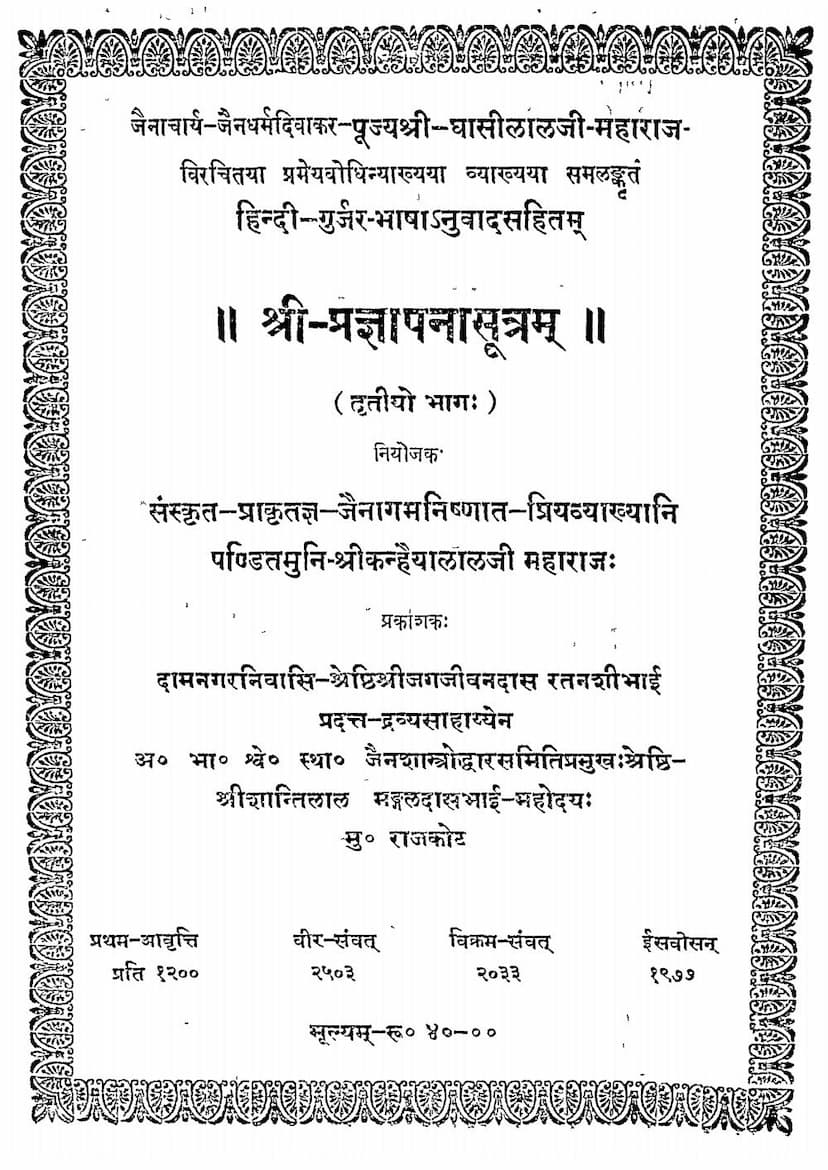Pragnapanasutram Part 03
Added to library: September 2, 2025

Summary
Summary of Pragnapanasutram Part 03 by Ghasilal Maharaj
This summary covers the key concepts discussed in the third part of the Pragnapanasutram, as presented by Ghasilal Maharaj and translated with Hindi-Gujarati explanations. The text delves into various aspects of Jain philosophy, primarily focusing on the nature of existence, life forms, and the subtle principles governing them.
Overall Structure and Content:
The provided text is the third volume of the Pragnapanasutram, accompanied by the 'Prameyabodhini' commentary. It is structured into several chapters (pads), each addressing a specific topic within Jain cosmology and philosophy. The volume covers chapters seven through twelve, exploring concepts related to:
- Uchchvaspada (Chapter 7): This chapter details the breathing patterns (inhalation and exhalation) of various beings across different realms of existence, from hell beings (Nairayikas) to celestial beings (Devas) in various heavens and orchestras. It quantifies the duration of these breathing cycles based on their respective lifespans and states of consciousness.
- Samjna-pada (Chapter 8): This chapter discusses the different types of cognitions or mental states (Samjna) that beings experience. It enumerates ten types of Samjna, including food, fear, sexual desire, possession, anger, pride, deceit, greed, worldly-view, and the general cognition of existence. It then analyzes the prevalence of these Samjna in different life forms, from hell beings to celestial beings, and compares their intensity across these categories.
- Yoni-pada (Chapter 9): This chapter focuses on the concept of 'Yoni' (womb or origin) and its classification into three types: Shita (cold), Ushna (hot), and Shito-ushna (lukewarm). It examines which life forms are associated with each type of Yoni, considering their respective origins and karmic dispositions. The chapter also classifies Yonis into Sachitta (living), Achitta (non-living), and Mishrita (mixed) and analyzes their presence in different beings. It further categorizes them into Samvruta (closed), Vivruta (open), and Samvruta-Vivruta (partially open/closed) and discusses their distribution.
- Charam-Acharam-pada (Chapter 10): This chapter deals with the concept of "Charama" (ultimate or final) and "Acharama" (non-ultimate or intermediate). It applies this concept to various aspects of existence, including:
- Earths (Prithivi): Analyzing the Charama-Acharama nature of the seven hellish earths and the heavens.
- Worlds (Loka & Aloka): Discussing the Charama-Acharama nature of the universe and the non-universe.
- Forms of Existence: Examining the Charama-Acharama aspect in relation to different types of beings and their various states of existence.
- Matter (Dravya) and Sub-units (Pradesha): Analyzing the Charama-Acharama nature of matter itself and its constituent units.
- Body Constitutions: Discussing the Charama-Acharama nature of different body types based on the number of constituent particles (pradesha).
- Bhasha-pada (Chapter 11): This chapter is dedicated to the concept of language (Bhasha). It discusses the nature of language, its origin, and its classification into four types: Satya (truthful), Mrusha (false), Satyamrusa (partially true/false), and Asatyamrusa (unreal or conventional). It analyzes these categories in relation to different beings and their contexts, examining when language is considered truthful, deceptive, or merely conventional. It also explores the various functions and qualities of language, including volitional and non-volitional speech, and the linguistic expressions related to gender and intent. The chapter further delves into the specific characteristics of language used by different life forms, such as hell beings, various types of celestial beings, and their specific limitations and capabilities regarding language. It also provides an in-depth analysis of the subtle aspects of language, including the concept of 'Anna' (food) and its connection to language, the nature of 'Bhava' (states of existence) in relation to speech, and the characteristics of color, taste, smell, and touch in spoken language.
- Sharira-pada (Chapter 12): This chapter categorizes the five types of bodies (Sharira) that exist in the universe: Audarika (gross physical body), Vaikriyaka (alchemic or transformable body), Aharaka (mental body), Taijasa (fiery body), and Karmana (karmic body). It discusses the presence of these bodies in different life forms, from hell beings to celestial beings and humans, highlighting which bodies are available to each category of beings and their respective characteristics, such as their subtlety, origin, and lifespans.
Key Themes and Concepts:
- Classification and Quantification: A significant portion of the text is dedicated to classifying and quantifying various aspects of existence, such as the duration of breathing cycles, the prevalence of mental states, the types of origins, and the characteristics of bodies. This demonstrates a systematic and analytical approach to understanding the universe within Jainism.
- Causality and Interconnectedness: The text implies an interconnectedness between different aspects of existence. For example, the nature of breathing is linked to lifespans and the type of body, while language is considered to be influenced by mental states and physical bodies.
- The Role of Karma: While not explicitly detailed in this summary, the mention of 'Karmana Sharira' (karmic body) and the context of Jain philosophy suggest that karmic influences play a significant role in shaping the experiences and characteristics of beings.
- Subtlety of Language: The chapter on language (Bhasha) highlights the nuanced ways in which language functions, encompassing truthfulness, falsehood, convention, and the underlying intentions and contexts behind speech.
- The Nature of Existence: The detailed descriptions of different realms, lifespans, and the presence of various bodies provide a comprehensive picture of the Jain understanding of the universe and the diverse forms of existence within it.
Significance of the Text:
The Pragnapanasutram, as represented in this volume, is a foundational text in Jainism. It offers a detailed and philosophical exploration of Jain cosmology, ontology, and ethics. The commentary by Ghasilal Maharaj further illuminates these complex concepts, making them accessible to students of Jainism. The text emphasizes the importance of understanding the subtle principles of existence to attain spiritual liberation.